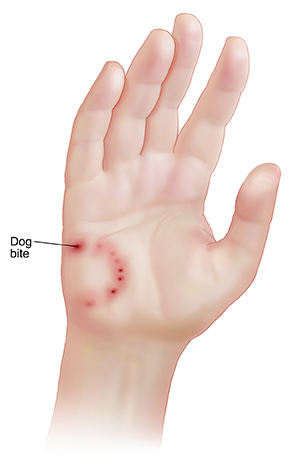A dog bite can cause a wound deep enough to break the skin. In these cases, the wound is cleaned and sometimes closed with stitches. Wounds will be closed if they're gaping open or in an area where scarring is a concern, such as the face. If the wound is closed, it usually isn't completely closed. This is so that fluid can drain if the wound gets infected. Often, wounds will be left open to heal. A tetanus shot may be given.
Home care
-
Wash your hands well with soap and warm water before and after caring for the wound. This helps lower the risk of infection.
-
Care for the wound as directed by your provider. If a dressing was applied to the wound, be sure to change it as directed.
-
If the wound bleeds, place a clean, soft cloth on the wound. Then, apply firm pressure until the bleeding stops. This may take up to 5 minutes. Don't release the pressure and look at the wound during this time.
-
Check the wound daily for signs of infection (see below). Most wounds heal within 10 days. But an infection can occur even with correct treatment.
-
If you’re given antibiotics, take them as directed. These medicines help prevent or treat infection. Be sure to take all of the medicine.
Rabies prevention
Rabies is a virus that can be carried in certain animals. These can include dogs and cats. Pets vaccinated against rabies are at very low risk of infection. But because human rabies is almost always fatal, any biting pet should be confined for 10 days as an extra precaution. In general, if there's a risk for rabies, you may need to take the following steps:
-
If someone’s dog has bitten you, it should be kept in a secure area for the next 10 days to watch for signs of illness. (If the pet owner won’t allow this, contact your local animal control center.) Ask to see the pet's vaccination records. If the dog stays healthy for the next 10 days, there's no danger of rabies in the animal or you. If the dog becomes ill or dies during that time, contact your local animal control center at once so the animal can be tested for rabies.
-
If a stray dog bites you, contact your local animal control center.
-
If in the next 2 days you can’t find the animal that bit you, and if rabies exists in your area, you may need the rabies vaccine series. Call your health care provider, or go to the emergency room right away.
-
All animal bites should be reported to the local animal control center. If you weren't given a form to fill out when you got care for the bite, you can report it yourself.
Follow-up care
Follow up with your health care provider, or as advised.
When to get medical advice
Call your provider or get medical care right away if:
-
You have signs of infection such as:
-
Spreading redness or warmth from the wound.
-
Increased pain or swelling.
-
Fever of 100.4ºF (38ºC) or higher, or as directed by your provider.
-
Colored fluid or pus draining from the wound.
-
-
You have signs of rabies infection. But don't wait for any of the symptoms below to start. If you suspect that the dog that bit you is rabid or if the dog is lost and can't be found, you should get the vaccine series. Symptoms of rabies include:
-
Headache.
-
Confusion.
-
Strange behavior.
-
Increased salivating and drooling.
-
Seizure.
-
Hallucination, anxiety, or agitation.
-
Fever.
-
-
You have trouble moving any body part near the wound.
-
You have bleeding that can't be stopped after 5 minutes of firm pressure.


